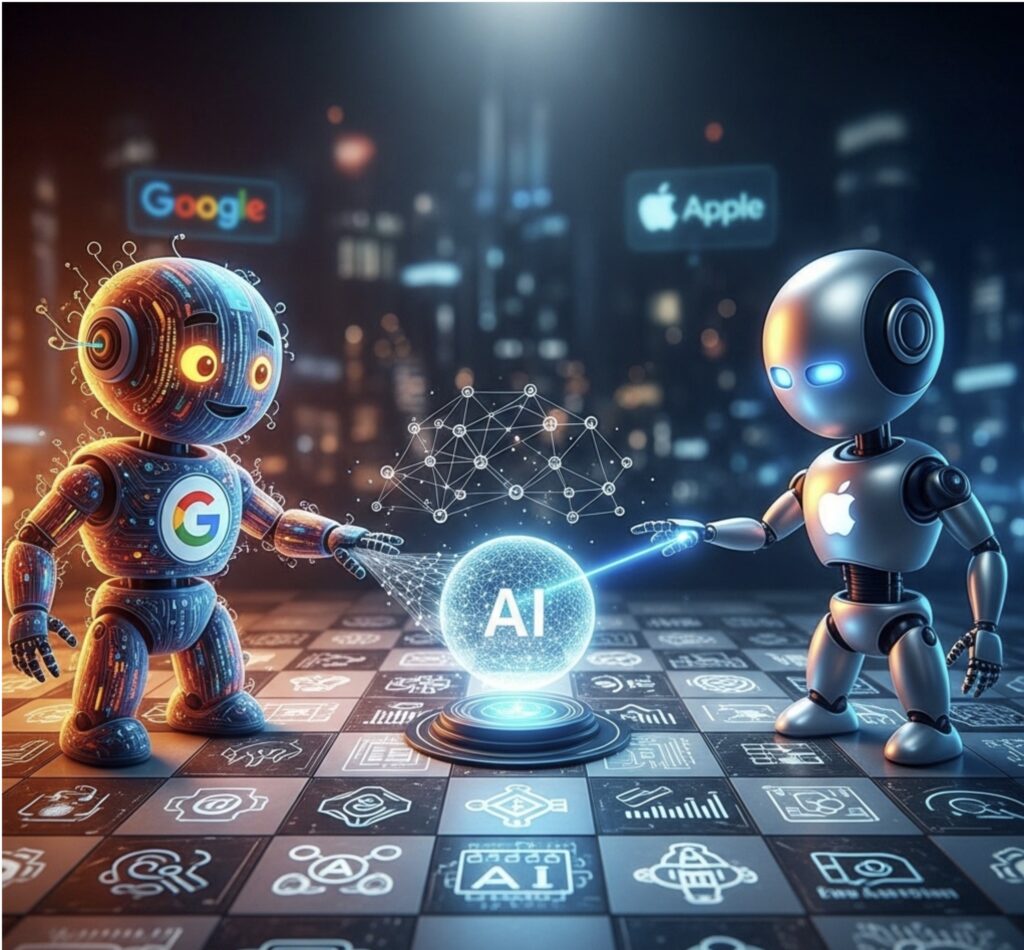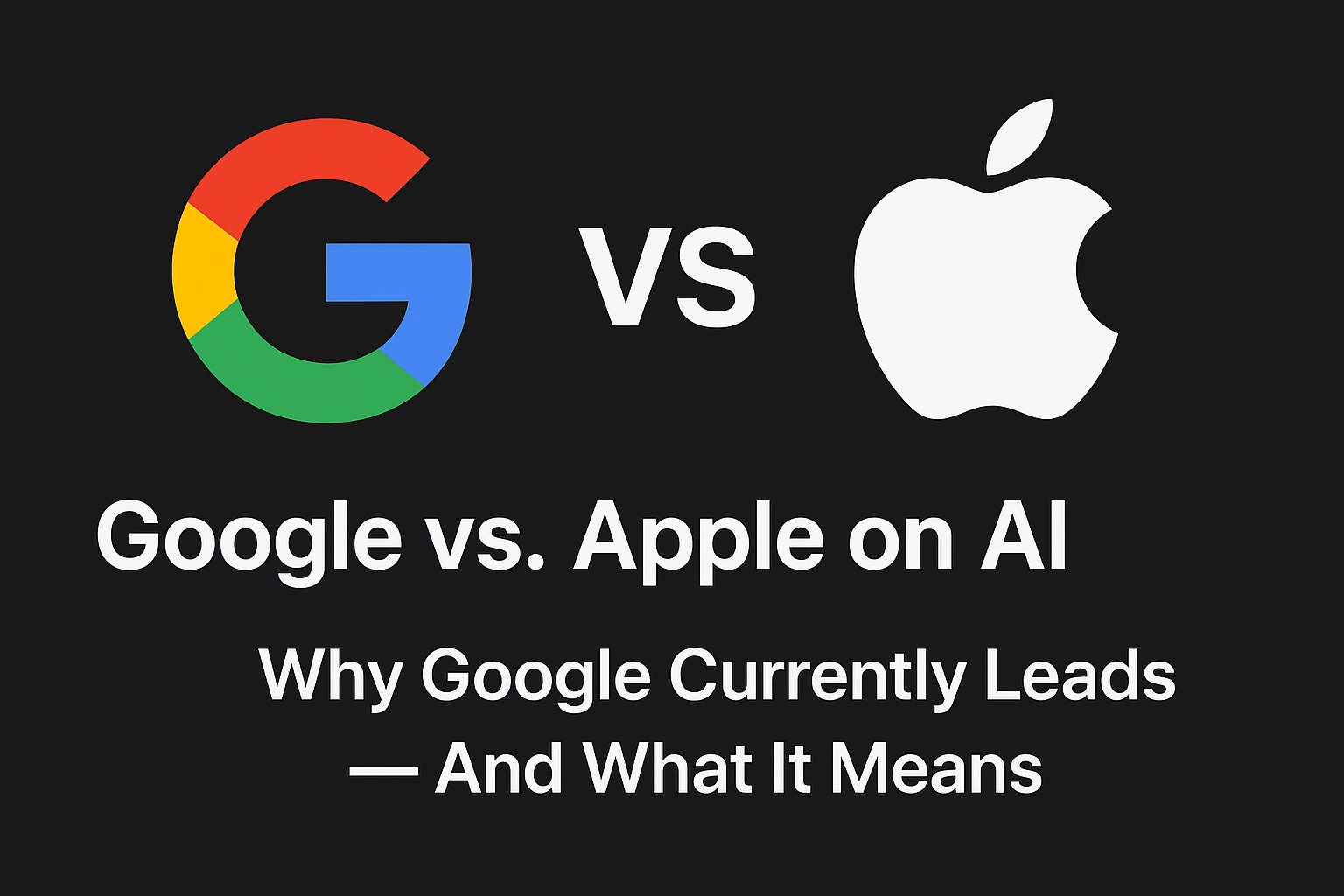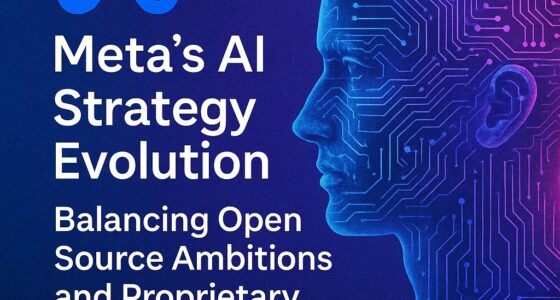Executive summar
Google has pulled ahead of Apple on delivered AI experiences in 2025. Google’s advantage isn’t just model quality; it’s the way Gemini is integrated end-to-end—from cloud TPUs to Android and Pixel hardware—so users feel proactive, context-aware help across apps and devices. Pixel 10 showcases this shift with Magic Cue, Gemini Live, and on-device translation/editing, all running on the new Tensor G5. Apple, meanwhile, has formidable silicon (M-series) and a coherent privacy posture, but the flagship “Apple Intelligence” features—especially a more context-aware Siri—have slipped on timing, creating a perception gap just as the market is forming around “AI phones.”

1) The integration edge: Google’s “proactive” stack
Google’s framing for consumer AI has shifted from reactive assistants to proactive, context-aware assistance. At the Made by Google event, the company explicitly contrasted its roadmap with slow AI rollouts elsewhere and positioned Pixel as the first truly “AI-forward” phone line. Magic Cue is the clearest proof: it watches context across Gmail, Calendar, Messages, Chrome, Photos and more, then surfaces the right information or action at the right moment—without a prompt or wake word. That’s qualitatively different from chat-style helpers and closer to an ambient agent woven through the OS
Why it matters: Proactivity shortens user intent → outcome loops (fewer taps, less copy-paste), which compounds into more daily engagement and stickiness. It also creates powerful first-party data signals (with user consent) to fine-tune on-device behaviors.
2) Pixel 10 as the reference “AI phone”
Pixel 10 turns the integration thesis into tangible features:
- Magic Cue: in-flow, cross-app suggestions (e.g., auto-bringing flight details from Gmail when you call the airline).
- Gemini Live: camera-aware, conversational help.
- Camera Coach & Pro Res Zoom: composition coaching plus a generative model in the camera pipeline for 100× zoom detail.
- Voice Translate: real-time call translation, including in the caller’s voice.
These are shipping experiences, not demos, and reviewers have called out Magic Cue as the clearest leap beyond today’s reactive assistants.
3) Silicon that serves the UX (not the benchmark): Tensor G5
Google’s Tensor G5 isn’t chasing raw CPU/GPU leaderboard crowns. It’s co-designed around running Gemini locally, with a TPU that’s ~60% more powerful than the prior generation and a CPU that’s ~34% faster on average, enabling on-device generative features to feel instant and private. That design choice aligns hardware throughput with the kinds of token-heavy, latency-sensitive workloads behind Magic Cue, Live Translate, and Recorder.
At the cloud layer, Google’s seventh-generation TPU Ironwood—designed specifically for inference—pushes the same philosophy at datacenter scale, powering proactive agents and long-context reasoning while improving perf-per-watt. Google is explicitly calling 2025 “the year of inference,” which maps to the user-facing pivot from chatbots to ambient assistants.
4) Extending beyond the phone: Gemini for Home
Google is also swapping Google Assistant for Gemini for Home on Nest devices, with early access starting in October 2025. That brings the same proactive, multimodal reasoning to speakers and displays, unifying the experience across phone and home. From a platform perspective, it’s a full-stack handoff—models, orchestration, and UX—to keep the assistant coherent wherever the user is.
5) Apple’s position: elite silicon, staggered software
Apple’s M-series remains world-class. The M4 Neural Engine is quoted at 38 TOPS and reflects Apple’s long-term bet on on-device privacy-preserving AI. But the software layer is where Apple is behind schedule. Apple publicly delayed key Siri upgrades—the contextual, cross-app actions that would mirror some of Magic Cue’s value—from 2025 to 2026, and has reportedly even weighed using third-party frontier models for parts of the stack. That timing gap—amid the first big consumer wave of “AI phones”—is strategically expensive.
Net effect: Apple’s chips are ready; the system-level AI behaviors (and developer hooks) are not broadly available yet. That creates a window for Android mindshare gains among power users, creators, and early adopters who rely on in-flow assistance.
6) Where Google’s lead is most visible (now)
- Cross-app proactivity: Magic Cue’s context spanning email, calendar, messages, browser, and photos—without prompting.
- On-device generative UX: Translation during calls, camera-native generative zoom, and recorder/screenshot intelligence run locally on G5.
- Unifying the assistant footprint: Gemini Live on phones and Gemini for Home on Nest devices shift the assistant from reactive voice to conversational agent across surfaces.
- Aligned hardware roadmap: Tensor G5 for on-device; TPU Ironwood for inference at scale, both optimized for the same family of models and agent patterns.
7) Strategic implications
- Product: The winning pattern is agentic, in-flow UX, not “apps that embed a chatbot.” For product teams, the bar is: Did AI shorten the path to outcome? Pixel 10 provides concrete patterns to emulate.
- Ecosystem: Google has first-party control over OS, assistant, models, and chips, which reduces integration friction. Apple has equivalent silicon control, but must land the Siri/Apple Intelligence layer at scale—reliably and soon.
- Privacy & trust: On-device inference is becoming a baseline. Google’s move to keep Magic Cue and many edits local, while giving users control over source apps, maps well to Europe’s regulatory climate and user expectations.
- Developers: Expect intent APIs and cross-app action frameworks to matter more than raw SDK endpoints. On Android, design for agent hand-offs (from Magic Cue/Gemini) and short, deterministic flows.
- Competition: If Apple lands Siri’s contextual actions in 2026—and pairs them with M-series and the iOS distribution advantage—the gap could close quickly. Today, though, Google sets the experiential bar for ambient mobile AI. Reuters
8) What to watch next (H2-2025 → 2026)
- Sustained proactivity: Do Magic Cue and Daily Hub maintain precision without feeling intrusive over months of real-world use?
- Model/UX coherence across surfaces: Gemini for Home’s rollout will test whether the same assistant truly “travels” with the user.
- Apple’s fall and 2026 cadence: Delivery of Apple Intelligence features—especially Siri’s on-screen awareness and app actions—will determine if Apple swings the spotlight back.
Bottom line
Google currently leads on lived AI—what everyday users can do right now—because its model→silicon→OS→UX loop is landing coherently and proactively on Pixel 10 and moving into the home. Apple still leads in raw client silicon and ecosystem lock-in, but its software timing has left a clear opening. If your goal is to design for the next two years of consumer AI, build for proactive, cross-app assistance that removes friction in context. Today, Google shows the template. Apple’s response will decide whether this lead becomes a durable advantage—or just a well-timed head start.
Backup – How Google is beating Apple on AI
Google integrates AI across its entire stack
- Proactive, context‑aware AI: Google’s goal is for its devices to anticipate what users need rather than simply respond to commands. A Made by Google blog post explains that Pixel devices use the Gemini family of models not only for features like voice assistance but also to proactively retrieve information, guide users to better photos, and even detect scams – “technology is moving from reactive to proactive”blog.google. This cross‑device integration (phone, tablet, earphones and other devices) allows the same model and memory of user context to follow the user.
- Unified hardware and software: Google is designing its own AI hardware for both data‑centre and consumer devices. In the data centre, the Ironwood TPU (TPU v7) is its most powerful inference chip. It can scale to 9,216 chips delivering 42.5 exaflops and has increased high‑bandwidth memory (192 GB per chip) and improved networkingblog.googleblog.google. Each chip contains a SparseCore accelerator for recommendation workloadsnextplatform.com. Google’s Axion CPU is its own ARM‑based processor which offers 30 % better performance than the fastest ARM cloud instances and 50 % better performance with 60 % better energy efficiency than comparable x86 VMshpcwire.com. The Axion CPUs are designed to work hand‑in‑hand with TPUshpcwire.com.
- Consumer chip – Tensor G5: In Pixel 10 Google introduced the Tensor G5 system‑on‑chip. Built on a 3 nm process, it features a TPU that is 60 % more powerful than its predecessor and a CPU that is 34 % fasterblog.google. The chip runs Gemini Nano (a compact generative model) entirely on‑device, enabling private and fast AI tasks; generative AI operations like transcribing audio or summarising content are 2.6× faster and twice as efficient as on the G4blog.google. Because the model runs locally, Pixel can deliver AI responses without sending data to the cloud.
Pixel 10: AI features that Apple lacks
Pixel 10 shows how deeply Google has embedded AI in a consumer device. Key features include:
| Pixel 10 feature | What it does | Evidence |
|---|---|---|
| Magic Cue | Proactively monitors apps (Gmail, Calendar, Messages, Chrome, Photos) and surfaces relevant actions without being asked (e.g., showing flight details from an email when you talk to a friend). Runs on‑device via Tensor G5 and Gemini Nano so no data leaves the phoneblog.googletomsguide.com. | Tom’s Guide notes Magic Cue is context‑aware and works across apps, unlike Siri which is purely reactivetomsguide.com. |
| Gemini Live/Visual Overlay | An upgraded assistant that can see through the camera and overlay suggestions on the viewfinder; for example, giving step‑by‑step guidance to perform a tasktechcrunch.com. | Integrates generative AI into the camera interface. |
| Voice Translate & Call Notes | Uses on‑device AI to translate live conversations in the user’s own voice in 11 languages and to create call summaries and actionable itemstomsguide.comtomsguide.com. | Shows Google’s ability to process speech and generate text on the fly. |
| Camera Coach & Pro Res Zoom | Camera Coach uses Gemini to suggest better framing; Pro Res Zoom uses generative AI to recover detail at up to 100× zoomblog.googletomsguide.com. | Demonstrates generative vision models working locally. |
| Ask Photos & Auto Best Take | Ask Photos lets users ask natural-language questions about their photo library (e.g., “show me the best photo from my hike”) and uses AI to search and edit; Auto Best Take combines multiple frames for the best group shottomsguide.comtomsguide.com. | Highlights cross‑modal understanding and generative editing. |
| Gemini Pro subscription | Buyers get a year of Gemini Pro, giving them access to the larger cloud models and features across Google Workspace and Searchtomsguide.com. | Shows integration between device and cloud AI. |
These features are not limited to specific apps but work across the OS, emphasising Google’s vision of AI as a core operating system component. Tom’s Guide characterises Magic Cue as a feature “Apple wishes it could make”tomsguide.com, and a later article notes that Pixel’s cross‑app AI functions are “the sort of feature Apple wishes it could make”tomsguide.com.
Hardware enabling Pixel 10’s AI
- Tensor G5 architecture: The chip uses one big, five medium and two small CPU cores and a TPU with up to 60 % more performanceblog.google. Although Google did not publicly disclose GPU details, analysis suggests it uses an Imagination DXT‑48‑1536 GPU and does not support ray tracingandroidauthority.com. Google prioritised AI acceleration rather than gaming features. Gemini Nano can process up to 32k tokens (roughly 100 screenshots or a month of email) on deviceandroidauthority.com.
Why Apple lags in AI
Missing or delayed features on iPhone
Apple’s Apple Intelligence aims to bring generative AI to iPhones, but key features have been delayed or are still absent:
- Next‑generation Siri delayed: A MacRumors report summarising Apple’s WWDC promises notes that the next‑generation Siri – capable of understanding personal context (reading texts, emails and notes) and performing tasks across apps – will not arrive until 2025macrumors.com. Reuters later reported that Apple’s own statement pushed some of these improvements to 2026reuters.com. This means iPhones still lack a proactive, cross‑app assistant similar to Google’s Magic Cue.
- Limited cross‑app AI: While iOS 18 includes writing tools, notification summarisation and minor photo edits, the ability to instruct Siri to find information in one app and use it in another (e.g., editing a photo then sending it in Messages) is not yet availablemacrumors.com. Android Authority notes that some of the best features of Apple Intelligence will not arrive until late 2025androidauthority.com.
- Need for cloud models: Apple’s AI features often require off‑device processing. For many queries Siri will suggest sending the request to ChatGPT, highlighting Apple’s reliance on external models, whereas Pixel’s Gemini Nano runs locally.
- Delayed roll‑outs: Apple initially said Apple Intelligence would ship with iOS 18, but Fortune/Bloomberg reported that the features were missing at launch and would arrive in later updatesfortune.com. Even when Apple Intelligence becomes available, features will continue to roll out “through late 2024 and the first half of 2025”fortune.com.
Hardware: powerful chips, limited software
- M‑series chips with strong neural engines: Apple’s M4 SoC (used in the 2024 iPad Pro) is built on a second‑generation 3 nm process and features up to a 10‑core CPU and 10‑core GPU. Apple claims the neural engine can perform 38 trillion operations per second, making it faster than the neural processing units in current AI PCsapple.com. The M4 has high memory bandwidth (up to 546 GB/s in M4 Max), enabling developers to run large language models locallytheregister.com.
- Despite hardware capability, AI software lags: Apple’s M chips provide strong AI compute, but without software that can utilise them, the user experience remains limited. Siri still requires network requests for many tasks, and Apple’s generative features are not yet integrated across the OS.
Comparison: Google vs Apple on AI
| Aspect | Google (Pixel 10 & ecosystem) | Apple (iPhone & M chips) |
|---|---|---|
| Approach to AI | Uses Gemini models across Search, Workspace, Pixel and Cloud; aims for proactive assistants that know context and act without commandsblog.google. | Apple Intelligence is mostly reactive and still depends on explicit commands; cross‑app understanding has been delayed to 2025–26macrumors.comreuters.com. |
| On‑device AI | Tensor G5 runs Gemini Nano locally; features like Magic Cue, Voice Translate and camera functions work offlineblog.googleblog.google. | M‑series chips have powerful neural enginesapple.com, but many Apple Intelligence features still require cloud processing and call ChatGPT. |
| Cross‑app actions | Magic Cue and Pixel 10 features can pull data from multiple apps and suggest actions (e.g., retrieving flight info while on a call)blog.googletomsguide.com. | Siri cannot yet perform tasks that involve multiple apps; such features are delayed until at least late 2025macrumors.com. |
| Call screening and live translation | Pixel has Call Screen and Voice Translate that summarise or translate calls in real timetomsguide.com. | iPhone lacks comparable call screening or on‑device live translation; some features may rely on network services or third‑party apps. |
| Camera AI | Features like Camera Coach and Pro Res Zoom use generative AI to improve framing and zoom qualityblog.google. | Apple’s camera offers AI‑enhanced photography, but generative editing features (e.g., removing objects) are limited and rely on iCloud or third‑party tools. |
| Hardware integration | Google designs custom TPUs, CPUs (Axion) and device chips (Tensor G5) so that hardware and software are co‑designed for AIblog.googlehpcwire.com. | Apple’s M chips are powerful and energy efficientapple.com, but the AI software ecosystem has not yet caught up. |









